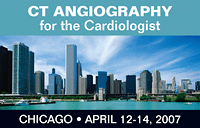Progress made in cardiac CT coding and reimbursement
CHICAGO — Cardiologists’ and radiologists’ efforts to receive proper reimbursement for cardiac computed tomography angiogram have been moving forward.
“The coding effort has actually been more successful than we would have expected,” Gregory S. Thomas, MD, MPH, said at the CT Angiography for the Cardiologist Symposium. “I think a lot of the reason has been the collaboration among a lot of different groups. The Society of Cardiovascular Computed Tomography, the American Society of Nuclear Cardiology, the Society for Cardiovascular Angiography and Interventions, the America College of Radiology and the American College of Cardiology have worked together in a collaborative effort to get computed tomography paid.”
The T codes
The development of the “T” codes has also been a combined effort, Thomas, president of the American Society of Nuclear Cardiology, said.
“Initially, the American College of Cardiology, the American College of Radiology and Blue Cross recommended category three codes, which are emerging technology codes for cardiac CT codes,” he said.
Thomas said that four codes were presented to the American Medical Association Current Procedural Terminology panel in New Orleans two years ago, and the panel decided to break up the four codes into eight separate ones.
“They were concerned we were going to do one for morphology, one for calcium scoring and one for coronaries,” Thomas said. “We have a permutation for morphology with coronaries with or without calcium scores.”
The CT angiography category three codes are 0144T, for calcium scoring only; 0146T for coronaries alone; 0145T for cardiac morphology (pre-Ep-code); 0150T for congenital studies, non-coronary; 0147T that covers coronaries and calcium scoring; 0148T for coronaries and cardiac morphology (pre-EP code); and 0151T that covers right ventricular ejection fraction/LVEF and wall motion.
Another reason for CT codes is that researchers do not know what the right CT angiogram procedures should be, Thomas said.

“Two years ago as these codes were being developed we gave people the freedom to do what they were going to do, and bill that, and we could collect that,” he said. “As the techniques emerged, we could see what the most common procedures were. When these become category one or regular codes, then we’ll have a smaller number of codes.”
The road to category one
Thomas said to receive category one status CT has to be available throughout the United States, which happened in the last two years. CT also needs to be preformed by a large percentage of practitioners. He said this is also occurring.
What prevents CT from category one status is a lack of definitive clinical efficacy.
“What we have is data that are like a heart cath,” he said. “We have data indicating a very good correlation between invasive cath or invasive angiography in CT angiography. We have few studies showing how it’s helpful for us in the emergency room.”
Thomas explained that studies are needed to show that practitioners changed their course of treatment based on CT. “[T]his is why we are slow in getting coding and why it’s more of a challenge,” Thomas said.
Stakeholder organizations like the ACC and ACR will look over the collected clinical utility data in an attempt to get the coding in the next year and a half.
“We need papers to document that we are making things better and that will help us get paid for our procedures,” Thomas said. “Likely what will happen is that we’ll defer for another year as we re-evaluate these papers and then we will present them to the American Medical Association CPT Panel in mid to late 2008.” – by Paul Burress
For more information:
- Thomas GS. Cardiac CT coding and reimbursement. Presented at: the 3rd Annual CT Angiography for the Cardiologist Symposium; April 12-14, 2007; Chicago.
